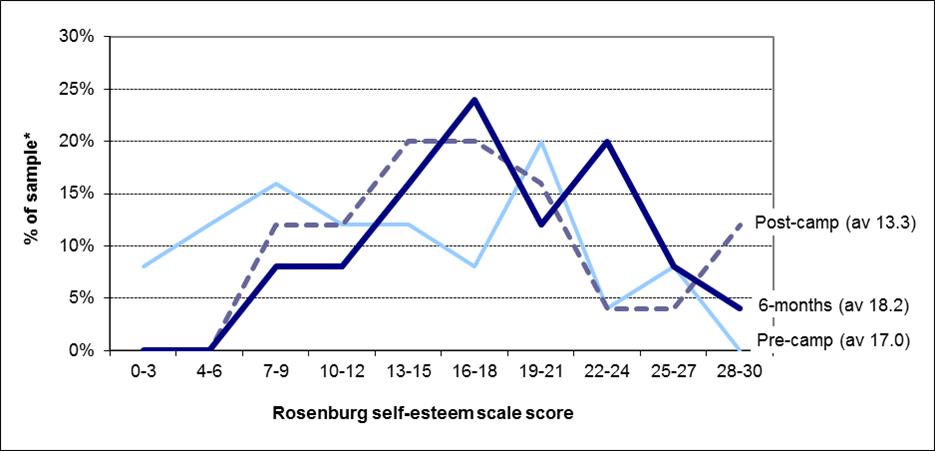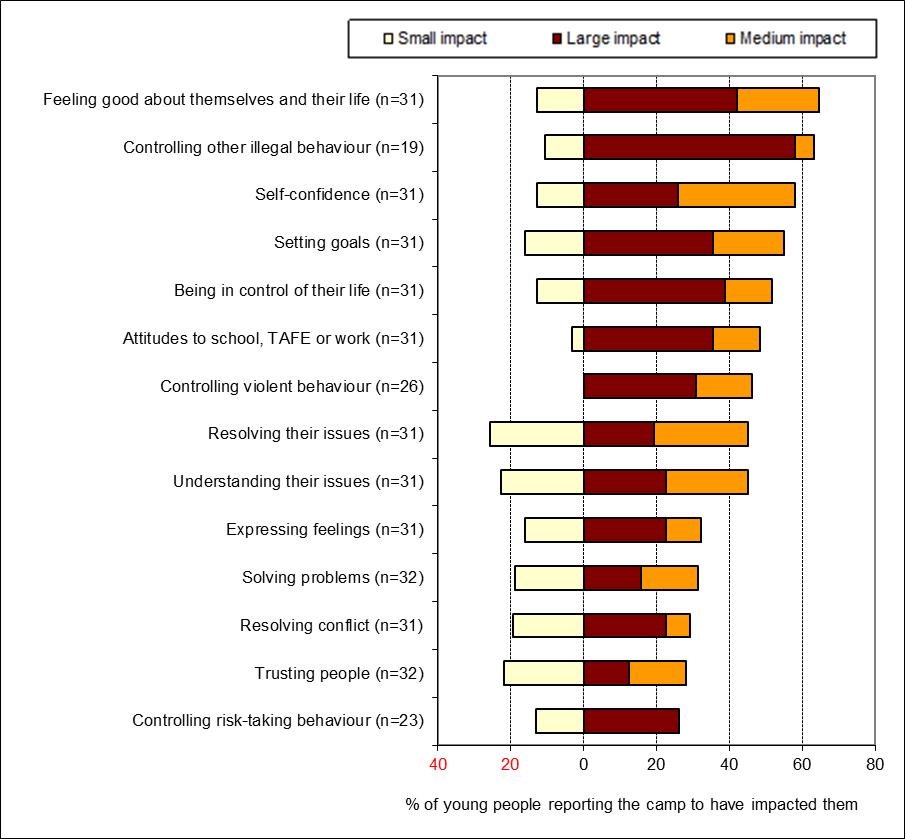Outcomes for Young People

Outcomes for Young People
The Urbis reviews found positive outcomes across multiple behaviour and well-being measures and found the program had a sustained positive impact on these issues. The Urbis (2003) review evaluated participants before and 6 months after participation. The relevant pages of the report are: 31, 33, 40, 42-43, 45 and 69 (2003). In summary, the outcomes 6 months after, for those sampled, were as follows, finding significantly:
- Less trouble with police and crime: 83% of those who had been in trouble with the police had not been since.
- Improved family relationships: there was a 70% increase in those that reported a ‘good’ or ‘really good’ relationship with their family (up from 31% to 53% of the sample).
- Reduced suicidal thoughts and attempts: 65% of those that were suicidal, were no longer suicidal, and 80% of those who made suicide attempts pre-program, had not done so since.
- Reduced alcohol and drug use: there was a 66% increase in those not drinking, a 50% decrease in those that drank frequently (a few times a week), and a 33% increase in the number that hardly drank. For those still drinking, there was a 150% increase in those not getting drunk (down from 72% to 53% of the sample), and most of those who still got drunk did so less frequently, for example those that got drunk everyday dropped 67%. Far fewer used drugs, with a 71% increase in those not using (up from 43% to 75% of the sample). For those still using, most reduced the frequency of their use.
- Better attendance and attitude to education: a much larger number (58%) had positive attitudes to their education then pre-program (up from 11%) and were interested in non-school education (up from 37% to 72%).
- Improved life skills: the program had led to big (for most) and some improvement (for others) for: setting goals (69%); resolving their issues (69%); understanding their issues (66%); solving problems (50%); trusting people (50%); resolving conflict (47%); expressing feelings (47%).
- Confidence and control: the program had led to big (for most) and some improvement (for others) for: feeling good about themselves and their lives (75%); self-confidence (69%); being in control of their life (62%); controlling risk taking behavior (29%).
- Less violent: the program had led to big (for most) and some improvement (for others) on controlling violent behavior for 37% of the sample group.
- Higher self-esteem: of a pre-program base line of 41% participants with low self-esteem (low Rosenberg score), 65% had higher scores immediately after, and 76% had higher scores 6 months later, markedly better than the pre-program scores, and even somewhat better than the immediate scores. The diagram below is the Rosenburg Self Esteem Index: distribution of pre-program, post-program and six-month scores.

The Urbis (2003) review found, “the follow up surveys also clearly indicate other lasting changes ascribed to the program, both immediate, and 6 months after” (p.67):
- More stable relationships with friends and close contact with friends from camp.
- Being more expressive, open about experiences, feelings, emotions, in touch with their feelings.
- Motivated to change.
- Feeling good about themselves and their lives, being calmer, more relaxed, controlled, less agitated and anxious.
- Being more mature, cooperative, better behaved, more participative.
- Being more social, communicative, less of a ‘loner’, having less conflict with peers, more positive interactions.
- Having better relationships with support adults.
- Having a clearer perspective on their life/problems.
- Trusting more.
- Being more comfortable seeking help
- Gaining employment.
The broad impact of the program as reported by young people is shows in the following table (Urbis: 2003: pg.48).
 The outcomes of the Urbis (2008) review confirmed these strong results finding similar results including that (pp.9-13 and pg.24):
The outcomes of the Urbis (2008) review confirmed these strong results finding similar results including that (pp.9-13 and pg.24):
- “[There is] a broad range of positive immediate outcomes … in particular making new friends and meeting others with similar problems, feeling loved and respected as well as feeling respect for others and having support” .
- “The data collected from the internal evaluation surveys demonstrates a range of positive behavioural outcomes for young people, such as increased school attendance, a reduction in drug and alcohol use, and a reduction in the perpetration of physical violence”.
- “Feedback from young people themselves is … very positive, as indicated by the range of attitudinal outcomes reported in the internal evaluation surveys, such as increased feelings of respect, love and support. Positive feedback is also indicated by the high proportion who return for second and more camps”.
- “[86%] … of … young people agreed that the [program] had helped them address the issues they had before coming to camp, and [95%] said they had found the [program] helpful.”
- “A strong reduction in non-prescribed drug use among those who used drugs prior to attending. Almost one in two young people (45%-49%) responded that since attending their last camp they were no longer using non-prescribed drugs. A further 16%-21% claimed they were using drugs less.”
- “Alcohol consumption among those who previously drunk alcohol, also reduced after attending: Sizeable proportions of young people claimed they had stopped drinking at all since attending (17%-29%). A similar proportion of young people claimed to be drinking less now than before (26%-32%).”
- “22% of young people had committed a crime prior to participating … and … following the [program] only 7% stated that they would commit another crime”.
- “A reduction in the prevalence of physical violence”.
- “Positive outcomes are evident with regard to increased school and university attendance”.